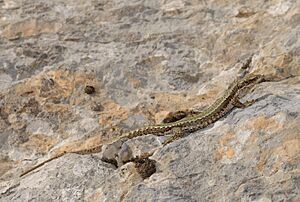Horvath's rock lizard facts for kids
Quick facts for kids Horvath's rock lizard |
|
|---|---|
 |
|
| Conservation status | |
| Scientific classification | |
| Genus: |
Iberolacerta
|
| Species: |
horvathi
|
| Synonyms | |
|
|
The Horvath's rock lizard (Iberolacerta horvathi) is a type of lizard found only in Europe. It belongs to the family called Lacertidae, which includes many common lizards. Until 1997, this lizard was thought to be part of a different group, Lacerta, like the sand lizard. Horvath's rock lizards usually live in cool forests, shrublands, and rocky places.
Contents
About the Horvath's Rock Lizard
What's in a Name?
The second part of the lizard's scientific name, horvathi, honors a Hungarian scientist named Géza Horváth. He was an entomologist, which means he studied insects.
How Big Are They?
Horvath's rock lizards are quite small. They grow to about 6.5 centimeters (about 2.5 inches) long, not counting their tail. They have a flat body and a somewhat blunt nose.
What Do They Look Like?
These lizards are usually pale grayish-brown on top. Their sides are a darker brown, which stands out against their light belly. Their belly is usually white or yellowish and doesn't have spots. Sometimes, you might see a faint dark line along their back or a few dark speckles. Young lizards look similar but often have a grayish-green tail.
Where Horvath's Rock Lizards Live
Geographic Range
Horvath's rock lizards are native to parts of northwestern Croatia, Slovenia, and nearby areas of northeastern Italy and southern Austria. There have also been reports of them in southern Germany. They can be hard to spot because they look a lot like the more common wall lizard, Podarcis muralis, which lives in the same areas at lower elevations.
Preferred Habitat
These lizards love rocky places. You can find them on cliffs, rocky outcrops, karst pavements (a type of rocky landscape), and areas with lots of boulders. They also live in alpine scrub, damp open woodlands, and even on embankments and bridges. They typically live at high altitudes, from about 500 to 2000 meters (about 1,600 to 6,500 feet) above sea level. Most often, they are found between 800 and 1200 meters (about 2,600 to 3,900 feet).
Horvath's Rock Lizard Behavior
Agile Rock Climbers
Horvath's rock lizards are experts at living on rocks. They are very agile and can even jump into the air to catch their prey. They like humid (damp) places and can even be active when it's cloudy outside.
What Do They Eat?
These lizards eat a variety of small invertebrates. This includes insects that fly, which they are good at catching.
Life Cycle and Reproduction
Laying Eggs
Female Horvath's rock lizards lay small groups of eggs, usually four or five at a time. The eggs hatch after about five to six weeks.
Young Lizards
When they first hatch, the young lizards are about 2.5 centimeters (about 1 inch) long from their snout to their vent (the opening near the base of their tail). They become fully grown and ready to have their own young when they are about two years old.
Conservation Status
The places where Horvath's rock lizards live in central and southern Europe are spread out and separated. Scientists believe their habitat was much larger during the last ice age. Because their living areas are small and broken up, there's concern for their survival. This is why the IUCN Red List lists them as "Near threatened". They are also legally protected in the countries where they live.


